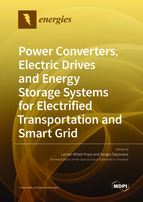Power Converters, Electric Drives and Energy Storage Systems for Electrified Transportation and Smart Grid
A special issue of Energies (ISSN 1996-1073). This special issue belongs to the section "A1: Smart Grids and Microgrids".
Deadline for manuscript submissions: closed (15 December 2020) | Viewed by 40860
Special Issue Editors
Interests: automotive electronics; embedded HPC (high-performance computing); enabling technologies IoT (Internet of Things)
Special Issues, Collections and Topics in MDPI journals
Interests: intelligent controllers and energy management; power converters and control; power electronics for energy access; electric vehicles: drivers and charging; model predictive control for power converters; electrical machines and motor drives for transportation electrification
Special Issues, Collections and Topics in MDPI journals
Special Issue Information
Dear Colleagues,
We are inviting submissions to a Special Issue of Energies entitled “Power Converters, Electric Drives, and Energy Storage Systems for Electrified Transportation and Smart Grids”.
Research activities in the field of energy storage technologies, management, and systems, and in the field of advanced electromobility, are essential for the success of electric transportation and to foster the use of renewable energy sources. Indeed, renewable energy sources are intermittent in nature and are not directly matched with users’ requirements. Energy storage systems are the key technology to solve these issues and to increase the adoption of renewable sources in smart grids. However, major challenges have still to be solved such as the design of high-performance and cost-effective energy storage systems; power electronics for the monitoring and management of battery cells and packs (BMS); the on-line estimation of state-of-charge/state-of-health of batteries and super/ultra-capacitors; the estimation of aging effects; the design and optimization of fast chargers, including also wireless power transfer; and integration within the smart grid of the charging infrastructure for e-transportation. For both chargers and BMS, cybersecurity, digitization, and interconnectivity with the infrastructure, partly thanks to the advent of 5G, are important issues.
Power converters and electric drives also need optimization in terms of increased efficiency and the implementation of predictive diagnostic and predictive maintenance features. Advanced control techniques for power electronic converters and motors, which also exploit machine learning, artificial intelligence (AI), and deep neural networks (DNN), are emerging trends. Applications are for both full electric and hybrid vehicles. Beside the hardware parts, the role of software is also increasing and new design and verification methods have to be investigated to achieve high functional safety and security levels for accelerating clean energy innovation.
The main objective of this Special Issue is, hence, to provide timely solutions for the design and management of energy storage systems, of renewable energy sources, and of relevant power electronic converter systems and innovative electric drives.
The integration of all these systems within the smart grid for e-transportation and smart/green cities is also of interest for the Special Issue. With reference to this “internet of energy” scenario, the application of IoT (Internet of things) technologies to E-transportation and smart grids is also of interest, including opportunities and challenges due to cybersecurity and 5G.
The particular topics of interest of this SI include but are not limited to the following:
- New emerging technologies for power converters, electric drives, and energy storage;
- Ageing mechanisms of power converters, electric drives, and energy storage devices;
- Electronic control units for energy storage system monitoring and management;
- Online estimation of state-of-charge and state-of-health;
- Power electronic converters for renewable energy sources;
- Fast chargers and smart chargers for electric-vehicles, including wireless power transfer;
- Integration of charging infrastructures in the smart grid for E-transportation;
- Predictive diagnostic for renewables and energy storage systems;
- Methods for design and verification of HW and SW for energy storage and renewables;
- Embedded systems, machine learning, AI, DNN for energy storage, conversion, and management;
- Integration of IoT and digitalization into E-transportation;
- Cybersecurity and 5G connectivity challenges and opportunities for energy.
Prof. Dr. Sergio Saponara
Prof. Dr. Lucian Mihet Popa
Guest Editors
Manuscript Submission Information
Manuscripts should be submitted online at www.mdpi.com by registering and logging in to this website. Once you are registered, click here to go to the submission form. Manuscripts can be submitted until the deadline. All submissions that pass pre-check are peer-reviewed. Accepted papers will be published continuously in the journal (as soon as accepted) and will be listed together on the special issue website. Research articles, review articles as well as short communications are invited. For planned papers, a title and short abstract (about 100 words) can be sent to the Editorial Office for announcement on this website.
Submitted manuscripts should not have been published previously, nor be under consideration for publication elsewhere (except conference proceedings papers). All manuscripts are thoroughly refereed through a single-blind peer-review process. A guide for authors and other relevant information for submission of manuscripts is available on the Instructions for Authors page. Energies is an international peer-reviewed open access semimonthly journal published by MDPI.
Please visit the Instructions for Authors page before submitting a manuscript. The Article Processing Charge (APC) for publication in this open access journal is 2600 CHF (Swiss Francs). Submitted papers should be well formatted and use good English. Authors may use MDPI's English editing service prior to publication or during author revisions.
Keywords
- Emerging energy storage technologies;
- Ageing of energy storage and power converters;
- Fast chargers and wireless power transfer;
- Monitoring and management of energy storage systems and BMS;
- Embedded systems, machine learning, DNN for energy storage, conversion, and management;
- Power electronic converters;
- Renewable energy sources;
- Predictive diagnostic and maintenance;
- E-transportation chargers, including wireless power transfer, and smart-grids;
- Internet-of-energy and cybersecurity and 5G connectivity challenges and opportunities.







